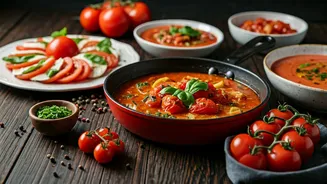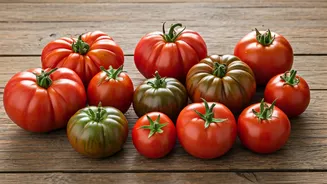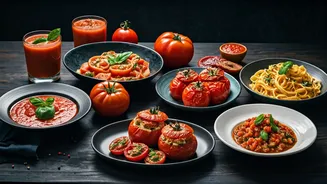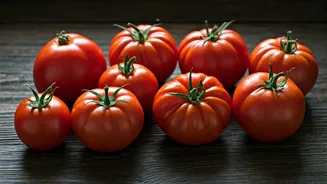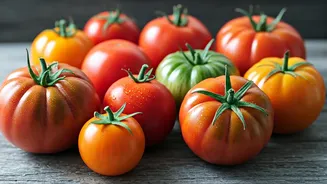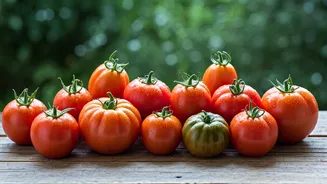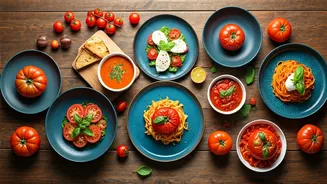Italian Pasta Perfection
Italy's contribution to tomato cuisine is unparalleled, especially in its pasta dishes. Imagine a classic Pasta al Pomodoro, a simple yet elegant preparation.
Fresh tomatoes, garlic, basil, and olive oil combine to create a sauce that coats perfectly al dente pasta. Then there is the rich, meaty Bolognese sauce, which features tomatoes simmered with ground meat, vegetables, and herbs. Another favorite, Amatriciana sauce, from Amatrice, utilizes tomatoes, guanciale (cured pork cheek), and Pecorino Romano cheese, offering a delightfully savory experience. The beauty of these dishes lies in their simplicity, allowing the natural sweetness and acidity of the tomatoes to truly shine. These tomato-based pasta dishes are the core of Italian cuisine.
Spanish Gazpacho Coolness
Spain brings us Gazpacho, a chilled soup that is a refreshing embodiment of summer. This uncooked soup traditionally incorporates ripe tomatoes, cucumbers, peppers, onions, garlic, and bread. Everything is blended to a smooth, velvety consistency. The variations in gazpacho are plentiful. Some add a touch of vinegar for a zesty kick, while others garnish it with croutons or finely chopped vegetables. This cold soup is a testament to how tomatoes, when paired with the right ingredients, can create a revitalizing and healthy meal. Whether it's a hot day or you're simply craving something light and flavorful, Gazpacho delivers.
Mexican Salsa Vibrance
Mexico is known for its vibrant and flavorful salsas, with tomatoes at the heart of many. Salsa Roja, a staple, combines roasted tomatoes, onions, chilies, and cilantro for a smoky, spicy flavor that complements various dishes. Salsa Verde offers a contrasting taste with tomatillos, green chilies, and herbs. Pico de Gallo, a fresh salsa, features diced tomatoes, onions, jalapeños, and cilantro, served uncooked. These salsas showcase the tomato's versatility, offering a spectrum of flavors. Whether you're dipping tortilla chips or adding zest to tacos, Mexican salsas enhance every meal with their rich blend of tastes.
Indian Curry Delights
Tomatoes are indispensable in Indian cuisine, often forming the base of many flavorful curries. Consider a classic Tomato Curry, where tomatoes simmer in a blend of spices like turmeric, cumin, and coriander, creating a rich, aromatic sauce. A variation, Tomato Dal, infuses the tomato flavors with lentils, adding a comforting and nourishing element to the dish. Tomato-based curries are often seasoned with ginger, garlic, and chilies, providing a balance of flavors that complement rice or naan. These dishes highlight how tomatoes are skillfully used to create complex, warming, and deeply satisfying meals.
French Ratatouille Magic
In the French countryside, Ratatouille is a popular vegetable stew. This dish celebrates the earthy flavors of tomatoes, along with eggplant, zucchini, bell peppers, onions, and garlic. The vegetables are typically sautéed or roasted individually before being gently simmered together with tomatoes, herbs, and seasonings. The beauty of Ratatouille lies in its simplicity. Each bite is packed with diverse textures and tastes. It can be served as a side dish, a main course, or even a topping for other dishes. It's a wonderful example of how the tomato harmonizes with other vegetables.
Turkish Menemen Flavor
Turkish cuisine presents Menemen, a simple yet satisfying dish consisting of scrambled eggs cooked with tomatoes, peppers, and onions. The tomatoes are often simmered to form a flavorful base. The peppers and onions add sweetness and depth to the dish. The eggs are then gently folded in. Seasoned with spices such as red pepper flakes, salt, and pepper, Menemen is a breakfast or brunch staple, offering a flavorful start to the day. This simple preparation showcases the versatility of tomatoes when combined with other fresh ingredients to create a satisfying meal.
American Ketchup’s Influence
Ketchup, a prominent American condiment, demonstrates the global impact of tomatoes. The traditional ketchup recipe uses tomatoes, vinegar, sugar, and various spices to create a sauce. Ketchup's sweet and tangy flavor complements everything from french fries to burgers. It has become a global phenomenon, with each culture adding its twist. It showcases how a simple ingredient, like the tomato, can evolve into a global staple through culinary innovation. Its widespread use exemplifies the tomato's ability to seamlessly integrate into diverse cuisines and dining habits.
Moroccan Tagine Aromas
Moroccan cuisine utilizes tomatoes in tagines, slow-cooked stews that offer an array of flavors. A lamb or chicken tagine may include tomatoes with spices like cumin, ginger, saffron, and cinnamon. The tomatoes provide both acidity and sweetness, blending seamlessly with the spices and other ingredients. Often, dried fruits like apricots or prunes are added to enhance the sweet and savory balance. The long, slow cooking process allows the flavors to meld, creating a rich and aromatic dish. The tomato is an essential part of the flavor profile, adding depth and complexity to the tagine.
Japanese Tomato Curry
Japanese cuisine has adapted tomato in innovative ways, with Japanese Tomato Curry. While curry may seem unusual, the Japanese have their own take, using tomatoes as a key ingredient, creating a hearty stew-like dish. The curry often includes tomatoes, meat (typically pork or chicken), and vegetables. The tomatoes give a slight tang and depth to the curry. This dish has a comforting warmth that pairs well with rice. It blends East and West influences. The tomato adds a unique, refreshing twist to the traditionally rich curry.
Global Tomato Soups
Tomato soups appear across many cultures. From a simple, comforting bowl to sophisticated creations, tomatoes create the foundation for these dishes. The creamy tomato soup in America is a traditional classic, often served with grilled cheese. In other cultures, tomato soup can be spiced with herbs, spices, or vegetables. Soups can also feature additions like croutons, cream, or a dash of olive oil. Tomato soups showcase the tomato's role. It is a fundamental ingredient, providing a base for creativity and flavor. They demonstrate the versatility of tomatoes in warming, flavorful dishes worldwide.


